A lecture given at the House of Lords at the invitation of the Global Warming Policy Foundation (GWPF) on 12 June 2023.
Wade AllisonEmeritus Professor of Physics and
Fellow of Keble College, Oxford
Hon. Sec. Supporters Of Nuclear Energy (SONE)
Nuclear energy is abundant and available 24×7 – if society wants it
Since life began on Earth there have been four energy revolutions. Now we stand at the threshold of the fifth. This should maintain the environment, follow the laws of natural science, and support the socio-economic needs of society. Only nuclear energy can match these, but a new spirit of informed public engagement is needed to replace seventy years of irrational aversion.
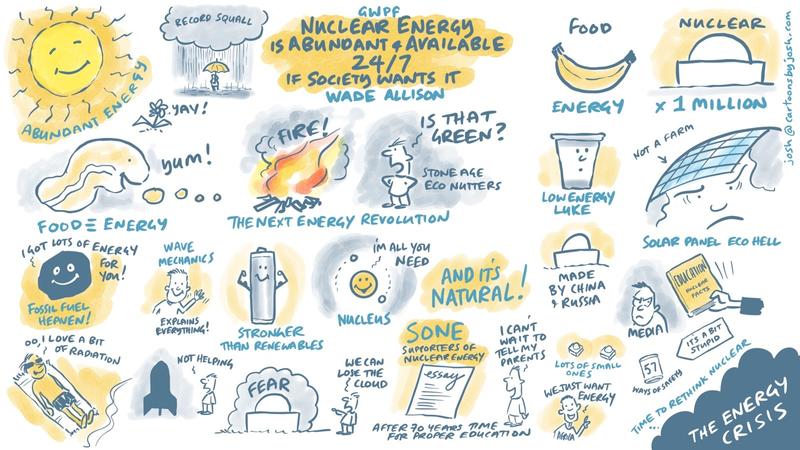
Abundant energy is essential for life, if life itself is to be abundant.
When life began some three billion years ago, the only sources of energy were the daily sunshine and the occasional volcanic geyser at a crack in the Earth’s crust. But whenever these sources failed, life’s activity faded too, as in winter.

But at some point evolution engineered a significant step forward in the use of energy. The extraordinary development of food and digestion enabled life – animals, birds and fish – each with their own personal internal engine, to move around and survive seasonal deprivation. However, the energy available to each was limited to the capacity of their own digestive system. This was only overcome in the third energy revolution, a revolution unique to mankind, a revolution enabled by the ability to study, to understand, to take sensible risks, and to teach others in society what individuals had found.
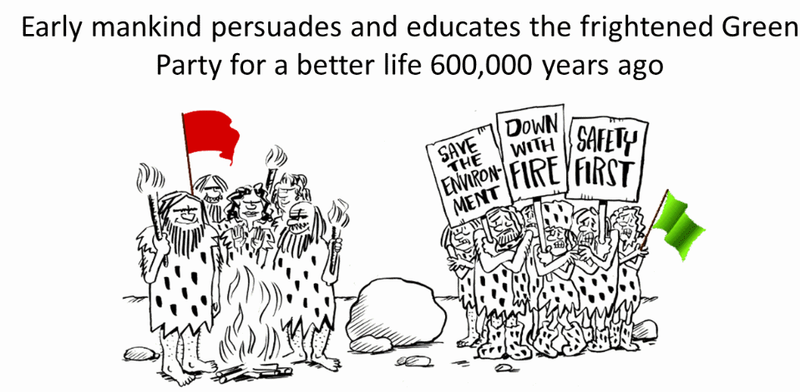
Excitement and fear are important providers of motivation and protection for animals. So humans have inherited a natural fear of energy and an inclination is to choose sources of energy that are weak and less threatening. But that is not the way we came to dominate life on the planet. Animals derive their energy from the food they eat, but modern humans use some hundred times more. Where can this come from and how well can it be controlled? Or rather, how well can fears of it be reined in by education and understanding – and so shared with society at large?
The acceptance of the use of fire was the turning point in human civilisation. Of course, fire is dangerous, and the proto-Green Party 600,000 years ago was right. But fortunately, their protests were overridden, otherwise human civilisation would never have become established. The discipline of handling fire had to be learnt and handed down to children with strict instruction from an early age – as it still is today. Fire can catch and spread like a virus, consuming all – which, incidentally, to anticipate what is to come later, neither radioactivity nor its radiation can do. Fire is put to work with knowledge based on experience, not with over enthusiasm or superstition. As Adam Smith put it:
Science is the great antidote to the poison of enthusiasm and superstition.
Or as Marie Curie expressed it:
Nothing in life is to be feared; it is only to be understood. Now is the time to understand more, so that we may fear less.
But we should distinguish natural science – that is how nature works – from technology – that is the exciting ways in which humans may put science to work.
We should check obvious evidence with care, for it can deceive. Experience in medicine shows that the truth is not simple to establish. It is well known that those who think they have been treated, when they have not, have an improved rate of recovery – the Placebo Effect. The Nocebo Effect occurs when people genuinely suffer by thinking that they have been injured when they have not. News that “you have been irradiated and are being evacuated from your home” acts like a curse, or Voodoo, and people genuinely fall ill. As in testing vaccines, establishing the truth requires blind trials and innocent subjects.
Nature’s food-powered engine has an important technical lesson for us. To work, its operating temperature, 37C, must be higher than ambient. Natural evaporation and sweating help, but an environment of 40-50C is not inhabitable without air conditioning and the energy to power it. The spread of uninhabitable regions, the rising tide of mass migration and the availability of air conditioning are existential problems. So the stability of society is particularly sensitive to changes in climate.
And our food-engine raises another point. Our bodies produce waste every day and any failure to control it carefully causes pollution and supports infectious disease. We educate children at a very early age what to do, and we restrict their social life until they learn. But what if we could find a source of energy, a fuel, with a million times the energy density of food? Then both the fuel and its waste would be about 1 kg for all the energy needs for one person for their entire life! If such an ideal waste also did not support infection, had a clean safety record, was simply contained and did not even smell, well, that would be close to perfection! Does such a perfect fuel exist?
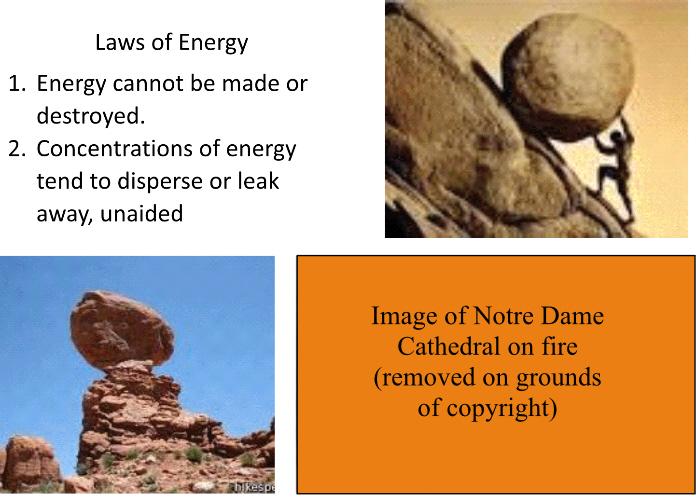
The Universe is brimming with energy but what is available on Earth now? We should look to the natural science of energy. Its laws are extremely simple, though mercilessly strict.
The First Law says:
“Energy cannot be made or destroyed under any circumstances.”
It may change form, but it must have come from some primary source. So
secondary sources like electricity and hydrogen need a primary source.
And it is the availability of primary sources that is the first
question.
The Second Law says:
“Concentrations of energy, that is fuel, tend to disperse or leak
away.”
So boulders like to roll downhill; water likes to flow away; hot cups of
coffee go cold and two lukewarm cups cannot make one hot cup. So there
is a premium on hot cups – that is high concentrations of energy.
So where might we find significant stores of primary energy that have not already dispersed? The Earth has been isolated, except for sunlight, for at least 5 billion years.
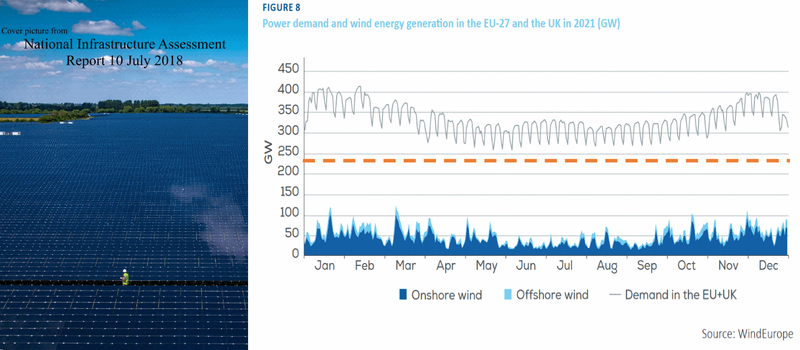
Sunlight powers the wind and weather but averages only 600 watts per square metre altogether. So these “renewable” sources demand vast areas of nature. How anyone who cares about the environment can advocate them is puzzling.
Here is a picture of a “meadow” near Abingdon, Oxford. It’s not a “farm”; not “green”; not environmental. Just a picture of Nature hijacked. Wordsworth would weep!
What about wind? Here are some data for the daily production EU + UK from the WindEurope Report for 2021. The installed capacity is 236 GW, but the daily maximum generated in the year was only 103 GW. Evidently wind is highly unreliable. Not only does it fluctuate, but the effect of its fluctuations on the power that it can deliver is massively amplified, as discussed in a recent paper for GWPF. The result is that wind power delivers only 20-30% of the time. Offshore wind is only marginally better, but equally bad for birdlife.
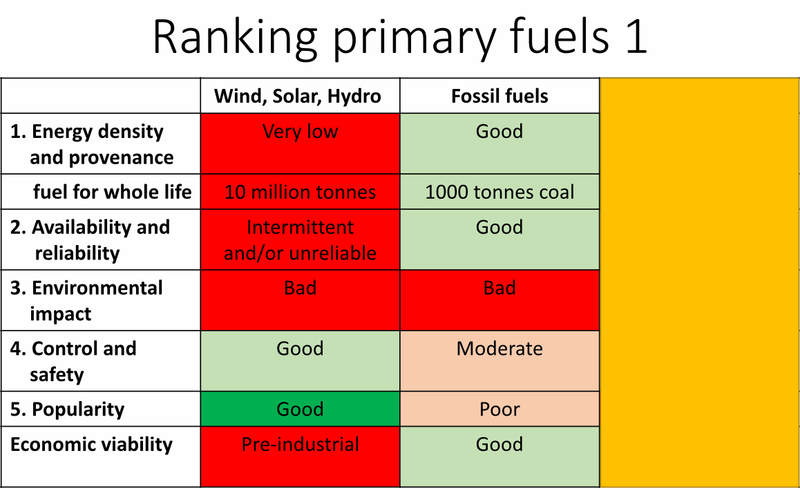
As soon as fossil fuels and steam power became available, the economic benefit of abandoning “renewables” was clear. The chemical power of fossil fuel combustion offered reliable 24/7 availability and thousands times more energy density – a thousand tonnes of coal give as much energy as ten million tonnes of water from a 100 metre high dam. Consequently, the wretched pre-industrial standard of living was transformed, the population quadrupled and life expectancy doubled. Politics came to be dominated by the question of who had access to fossil fuels, and who did not.
That left three concerns.
- Fossil fuels polluted the environment, especially in large cities, and were far from safe.
- The possible effect of fossil fuels on the global environment and climate.
- The scientific question “where is the mechanism of chemical energy?” Unlike wind, solar and hydro it seems to be hidden – you cannot feel it. Even “Could there be other hidden energies?”
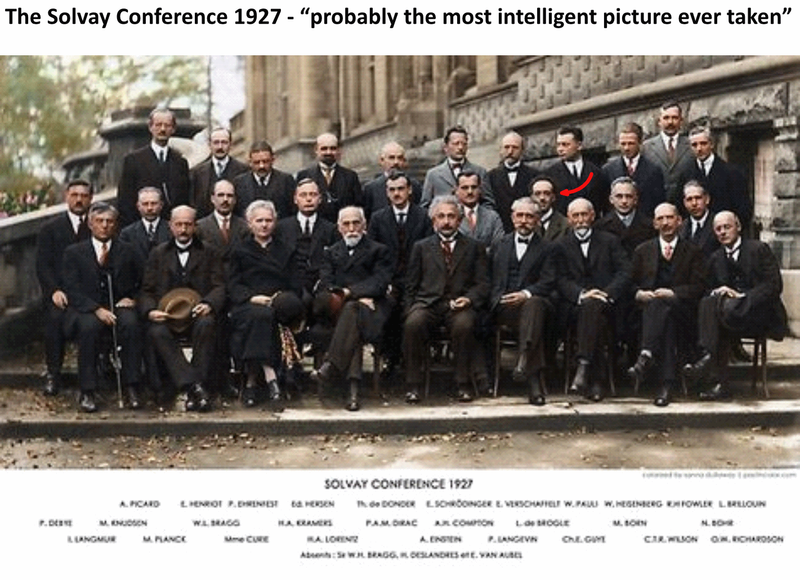
The scientific question was answered in 1924 by a French PhD student, Prince Louis de Broglie. In his thesis he suggested that all particles and light should be described by waves. He is marked in this photograph by the red arrow, where he appears with Planck, Einstein, Marie Curie, Schrödinger, Heisenberg, Dirac and some of the other brilliant people who checked out that this Wave Mechanics applies universally for everything.
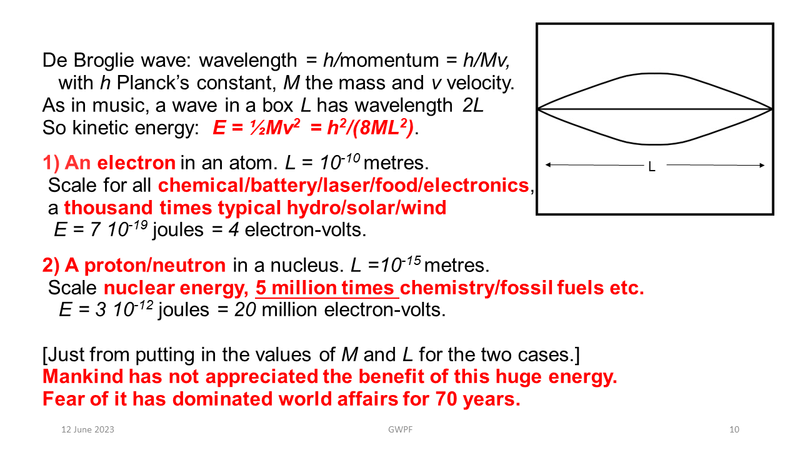
The waves for all matter have a wavelength \(L = h / M v\), where Planck’s constant \(h \approx 6.6 \times 10^{-34}\) joule-sec, \(M\) is mass in kg, and \(v\) is speed in metres per second.
That is the only unfamiliar bit – its centenary is next year! Though universal, it becomes significant only when \(L\) and \(M\) are very small. For instance, an electron trapped in an atom, like a sound wave in a musical instrument, has kinetic energy \(\frac{1}{2} M v^2\) and its size accounts well for the scale of all chemical, food, electronics and battery energies.
In exactly the same way, a proton or neutron in a nucleus, has energy \(\frac{1}{2} M v^2\) too. This nuclear energy is five million times greater than fossil fuels, basically because the nucleus is 100,000 times smaller. The rest, as they say, is history – and the future, too!
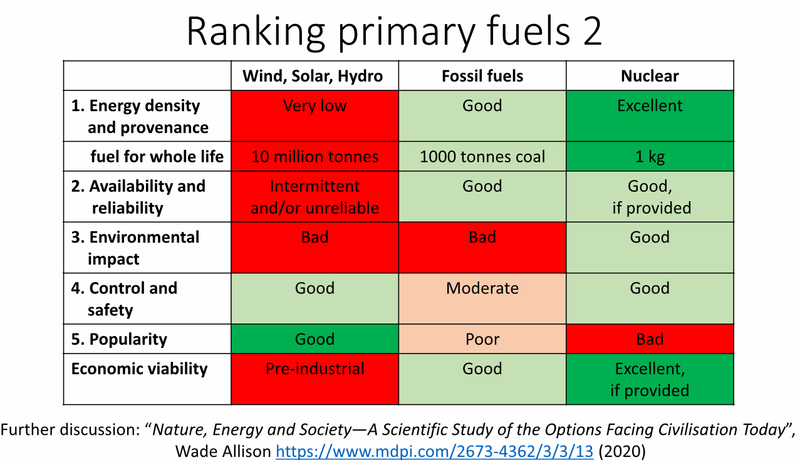
The quantity of fuel required, and waste created, are correspondingly reduced. Indeed just 1 kg of pure nuclear fuel can provide all the energy for life. There are just two conditions. The power plants need to be actually built, and the public need to be reassured, as they were when fire was introduced.
Since the thousand-fold increase in energy density transformed society in the Industrial Revolution, the further factor of a million available with nuclear energy should offer an even greater social uplift, as Winston Churchill presciently observed already in the Strand Magazine in 1931:
The discovery and control of such sources of power would cause changes in human affairs incomparably greater than those produced by the steam-engine four generations ago.
Whilst he had the vision, it was another 25 years before it was demonstrated that nuclear energy could be delivered under control and to order. Indeed, so effective is the natural security of nuclear energy that society thinks of it as man-made and unnatural – a view that still dogs its public image seven decades later.
Nuclear energy is the only road to future prosperity, but decision making is still weighed down by public unease exacerbated by unscientific regulations, particularly in democratic regimes. Note that in 2022 only China started the construction of a new nuclear power plant (IEA). And of the 31 reactors that started construction since 2017, all but four are of Russian or Chinese design.
The unease stems from concerns about safety and the effect of radiation on life. Einstein gave the first successful description of what happens when ionising radiation hits any material. The damage is confined to a small number of randomly chosen atoms or molecules that are smashed hard – while the rest are unaffected. In 1905, Einstein related this to quantum theory, work for which he received his Nobel Prize. In the case of living tissue this has enabled evolution to find ways to circumvent the damage – replacing cells, repairing broken DNA and other strategies – while relying on the undamaged health of the majority.
The attacking radiation is powerful, but its strategy does not change. Biology is weak, but over billions of years it has established ways to recover. This contrasts with an attack by a virus. Then the attacker is weak but also evolves, so that the contest with living tissue is not so easily settled – as we know from COVID.
Education is how society evolves. The accident at Fukushima Daiichi illustrates its effect. First came the earthquake and tsunami that killed nearly 20,000 people. But at school in Japan every child learns about these and practices what to do. So, despite the huge loss of life, society recovered. However, when the nuclear reactors failed and some radiation was released, nobody knew what to do, because they had never been told. The region was hurriedly and unnecessarily evacuated with the loss of some 1600 lives. Although not a single life was affected by the radiation itself, society lost confidence in science and authority. Locally, there were serious mental health, economic and environmental consequences. The panic spread around the world on a media-driven wave of excitement. None of this would have happened if the discussion at home and school about the natural world, that properly includes fire and human waste, had not excluded radioactivity and its radiation. Ionising radiation from the Sun – ultraviolet – is a serious cause of skin cancer. Protection from this more serious problem is properly handled in family healthcare, and sunbathing is not regulated by an arm of the United Nations.
Is there any evidence against a more positive attitude towards Radiation Safety? As pointed out earlier, blind trials and innocent subjects are needed. Blind trials with mice and dogs in controlled laboratory experiments are supportive. But most appealing are the available videos of wild animals in the Evacuation Zone at Chernobyl made by BBC and others. These animals have never seen the shock-horror stories about what happened at Chernobyl. The wildlife is seen as thriving, glad to be rid of the human population and free to roam undisturbed in their park.
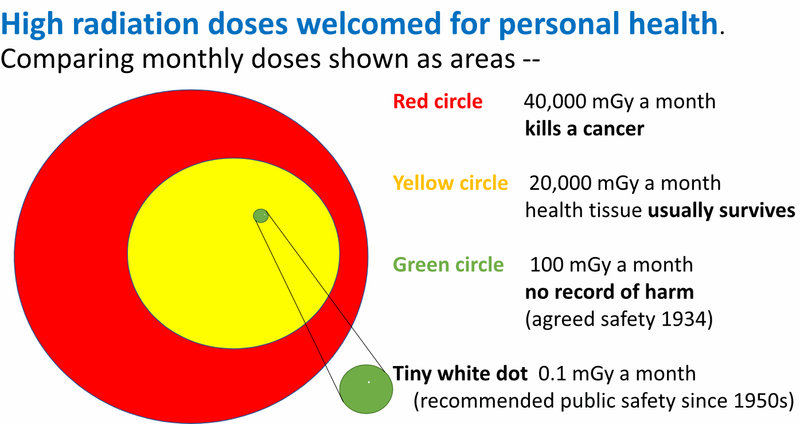
But the evolved protection against the effects of ionising radiation is effective only to a certain level. The mechanisms take time to act like all biological reactions – hours or days, depending on the cell cycle. They may be overwhelmed if a certain threshold is exceeded in a month, say. This has been studied for more than a century since Marie Curie first used radiation to diagnose and cure cancers. It is most easily described graphically, for instance with circles of area proportional to the monthly dose. The red circle shows a dose that is usually fatal to cells, including cancer. The yellow is a monthly dose from which most tissue recovers – for instance, the otherwise healthy tissue near a treated tumour. Everyone has a friend or relative who has had such treatment and lived to enjoy more years of life. The green circle is 200 times smaller (also shown magnified). This describes a monthly dose which, as internationally agreed in 1934, has no record of irreparable harm. Much has been discovered since 1934, but nothing that faults this value.
But in 1945 nuclear energy was used for war. Much worse, the 1950s was an era of worldwide secrecy, fear and distrust, fomented by Senator Joseph McCarthy. Since that time, the world, lead by the USA, has demonised nuclear energy and exaggerated caution by 1000 times without scientific evidence. The current safety regulations correspond to the area of the tiny white circle. Why have we allowed this to happen – and to persist for 70 years?
We should understand that nuclear and its radiation can be beneficial, not only for personal health, but for society and the environment. The naïve and unscientific assumption that a little radiation is harmful because that is true of an excess, has caused great loss of life at Fukushima, has escalated the cost of nuclear power by a large factor, delayed it by many years without reason. There is no expensive item, except the unwarranted fear that obstructs nuclear power. A new station should work 24/7 for 80 years. We just need to invest in the talents of our young people and retire most of the committees set up to protect our grandchildren from their own future and the energy revolution that they will sorely need.
So, it’s primarily a matter for education and legislative reform, and that will take some time, but the revolution to come will outshine the Industrial Revolution, as Churchill foresaw more than ninety years ago. We should give the younger generations all the encouragement we can.
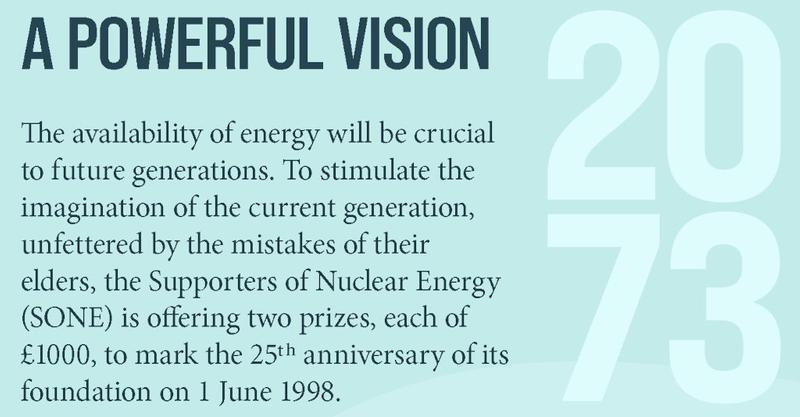
In this spirit SONE is offering two prizes for essays that imagine how the world of energy will look in 2073. They should be submitted by 31 August 2023 and will be judged for their realistic scientific and political imagination.
-
The Sir Bernard Ingham Essay Prize will be awarded to a UK resident under the age of 38 on 1 June 2023.
-
The Sir William McAlpine Essay Prize will be awarded to a student in full time school education in the UK.
The brief and further details may be found on the SONE website at https://sone.org.uk/sone-silver-jubilee-essay-competition/
I hope that you will spread the news of this opportunity and encourage young people to have a go. Contestants are required to state that submissions are their own work.
